A comforting, creamy homemade Potatoes Stroganoff that tastes even better than the boxed version. This hearty dish combines tender potato slices with savory ground beef in a rich mushroom sauce for a family-favorite meal that comes together in one large skillet.
Recipe Details
- Prep Time: 15 minutes
- Cook Time: 30 minutes
- Total Time: 45 minutes
- Yield: 6 servings
- Calories: 320 kcal (Estimated)
Why This Homemade potatoes Stroganoff Recipe Beats the Boxed Version Every Time
Have you ever found yourself reaching for that familiar box of hamburger helper potatoes stroganoff at the grocery store, drawn by its convenience and nostalgic flavor? If stroganoff was always my favorite growing up, you’re certainly not alone. However, once you discover how simple it is to make this copycat hamburger helper potatoes stroganoff from scratch, you’ll never go back to the boxed version again.
Moreover, this homemade version allows you to control exactly what goes into your meal. Furthermore, you can adjust the flavors to your preference and create a more nutritious dinner recipe without sacrificing any of that creamy, comforting taste that makes potato stroganoff such a beloved dish.
In this comprehensive guide, I’ll share everything you need to know about creating the perfect ground beef potatoes stroganoff right in your own kitchen. Additionally, we’ll explore simple variations, storage tips, and answers to common questions about this classic comfort food.
What Makes This potatoes Stroganoff Recipe Special
This homemade potatoes stroganoff recipe delivers all the flavors you love from hamburger helper but elevates them with fresh ingredients and thoughtful technique. The combination of thinly sliced potatoes, browned ground beef, and savory mushrooms creates a deeply satisfying meal that’s perfect for weeknight dinners.

What sets this recipe apart from the boxed version is the richness that comes from building layers of flavor. First, we brown the beef until it develops a delicious crust. Then, we sauté onions and mushrooms until caramelized before creating a velvety sauce that perfectly coats each potato slice. As a result, you get a homemade copycat that’s packed with authentic flavor and none of the artificial ingredients.
The tang from sour cream balances the savory elements beautifully, while the tender potatoes absorb all the delicious flavors as they cook. Consequently, each bite delivers the perfect balance of creaminess, heartiness, and comfort.
Essential Ingredients for Perfect Potato Stroganoff Hamburger Helper Recipe
To make this copycat hamburger helper potato stroganoff, you’ll need ingredients that are likely already in your pantry and refrigerator. Therefore, this recipe is not only delicious but also convenient for busy weeknights.
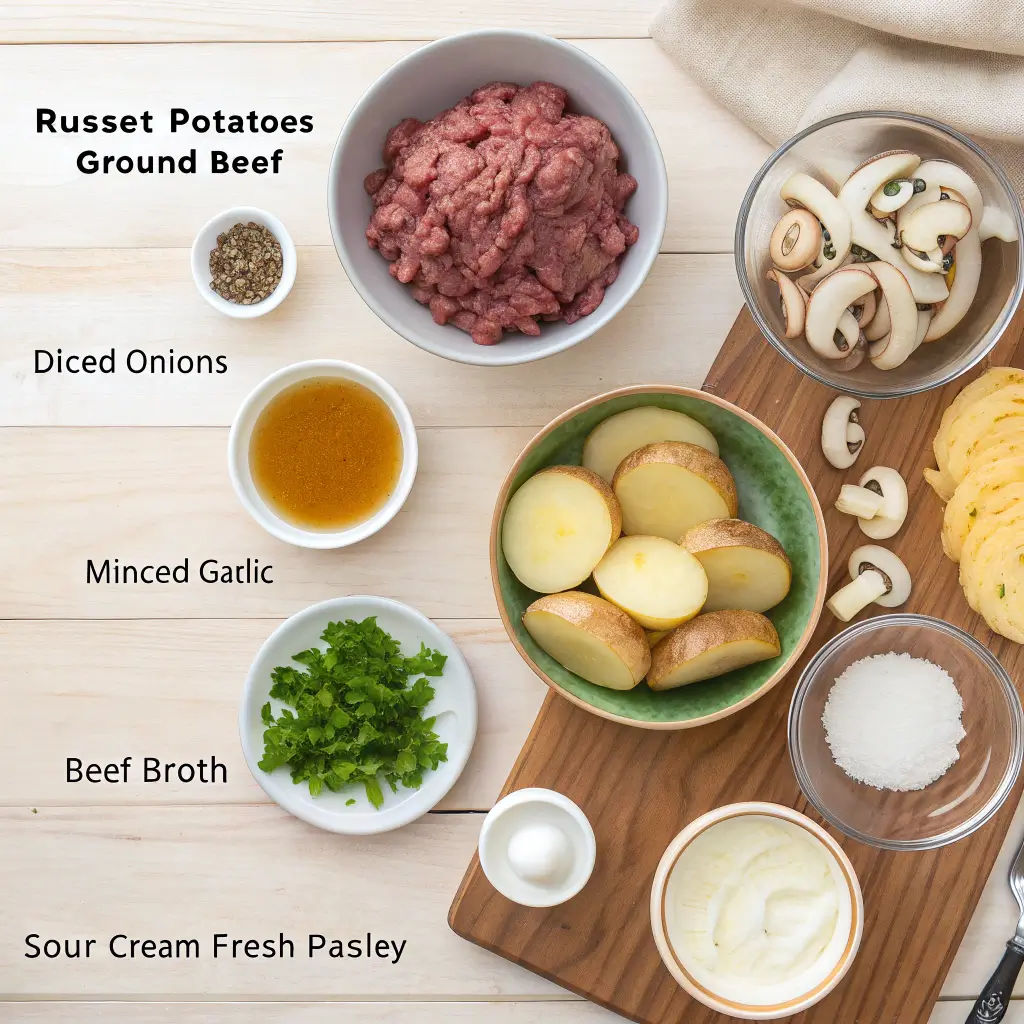
For the Stroganoff Base:
- 2 tablespoons vegetable oil
- 1 pound lean ground beef (85-90% lean recommended)
- 1 large onion, finely chopped
- 3 cloves garlic, minced
- 8 ounces mushrooms (cremini or white button), cleaned and sliced
- 2 tablespoons all-purpose flour
- 1 teaspoon paprika
- ½ teaspoon dried thyme
- 1 teaspoon salt (adjust to taste)
- ½ teaspoon black pepper
- 2 cups beef broth (low sodium recommended)
- 1 tablespoon Worcestershire sauce
- 1 teaspoon dijon mustard
- 1½ pounds russet potatoes (about 3 medium), sliced ¼-inch thick
For the Creamy Sauce & Finish:
- ¾ cup sour cream, at room temperature
- 2 tablespoons fresh parsley, chopped (for garnish)
How to Make potatoes Stroganoff with Ground Beef: Step-by-Step Instructions
Creating this stroganoff dinner is surprisingly simple despite its rich flavor profile. However, following these steps carefully will ensure your homemade potatoes stroganoff turns out perfectly every time.

Step 1: Prepare the Potatoes and Brown the Beef
First, begin by preparing your potatoes. For consistent cooking, use a mandolin to cut the potatoes into uniform ¼-inch slices. Then, place them in cold water to prevent browning while you prepare the other ingredients.
Meanwhile, heat 1 tablespoon vegetable oil in a large skillet with a lid over medium-high heat. Add the ground beef and cook, breaking it apart with a spoon, until deeply browned for maximum flavor. This should take about 5-7 minutes. Subsequently, drain off excess fat and set the beef aside.
Step 2: Sauté Aromatics and Create the Flavor Base
In the same skillet, add the remaining tablespoon of oil over medium heat. Then, add the chopped onion and cook until softened and translucent, about 4-5 minutes. Next, add the minced garlic and sliced mushrooms. Cook until the mushrooms release their liquid and start to brown, approximately 5-7 minutes.
Once the vegetables have softened, sprinkle the flour over them, along with the paprika, thyme, salt, and pepper. Then, stir constantly and cook for 1-2 minutes to cook out the raw flour taste. This creates the foundation for your sauce to thicken properly.
Step 3: Build the Sauce and Add Potatoes
Gradually pour in the beef broth while whisking constantly to avoid lumps. Stir in the Worcestershire sauce and dijon mustard for added depth of flavor. Then, bring the mixture to a simmer.
Drain the potato slices thoroughly and pat them dry. Return the browned beef to the skillet, then gently fold in the potato slices. Ensure the potatoes are mostly submerged in the liquid (add a splash more broth if needed). Bring back to a gentle simmer, then reduce the heat to low, cover, and cook for 18-20 minutes, or until the potatoes are cooked and fork-tender but not falling apart. Stir occasionally to prevent sticking.
Step 4: Finish with Sour Cream for Ultimate Creaminess
Once potatoes are tender, remove the skillet from the heat to prevent the sour cream from curdling. Let it sit for a minute or two to cool slightly. In a small bowl, whisk a few spoonfuls of the hot liquid from the skillet into the room-temperature sour cream (this is called tempering).
Gently stir the tempered sour cream mixture into the skillet until completely incorporated and the sauce becomes creamy. Remember, do not boil the sauce after adding sour cream or it may separate.
Finally, taste the stroganoff and adjust seasoning with more salt, pepper, or Worcestershire sauce as needed. If the sauce is too thick, stir in a splash of warm beef broth. If too thin, let it sit for a few minutes as it will thicken slightly as it cools.
Serve your homemade potatoes stroganoff hot, garnished generously with fresh parsley.
| Beef and Potato Stroganoff: Boxed vs. Homemade Comparison |
|---|
| Aspect |
| Ingredients |
| Sodium Content |
| Flavor Depth |
| Potato Texture |
| Customization |
| Cooking Time |
| Cost per Serving |
Essential Tips for Perfect potatoes Stroganoff Every Time
For the best results with your homemade copycat hamburger helper potatoes stroganoff, keep these helpful tips in mind:
Selecting and Preparing the Perfect potatoes for Stroganoff
The type of potato you choose makes a significant difference in this recipe. Russet potatoes work wonderfully because they hold their shape well when sliced and cooked properly. Alternatively, Yukon Gold potatoes offer a naturally buttery flavor that complements the creamy sauce.
When you cut the potatoes, aim for uniform thickness (about ¼-inch) to ensure they cook evenly. A mandolin can be incredibly helpful for achieving consistent slices. Additionally, soaking the sliced potatoes in cold water for 15-20 minutes helps remove excess starch, which prevents the stroganoff from becoming gummy.
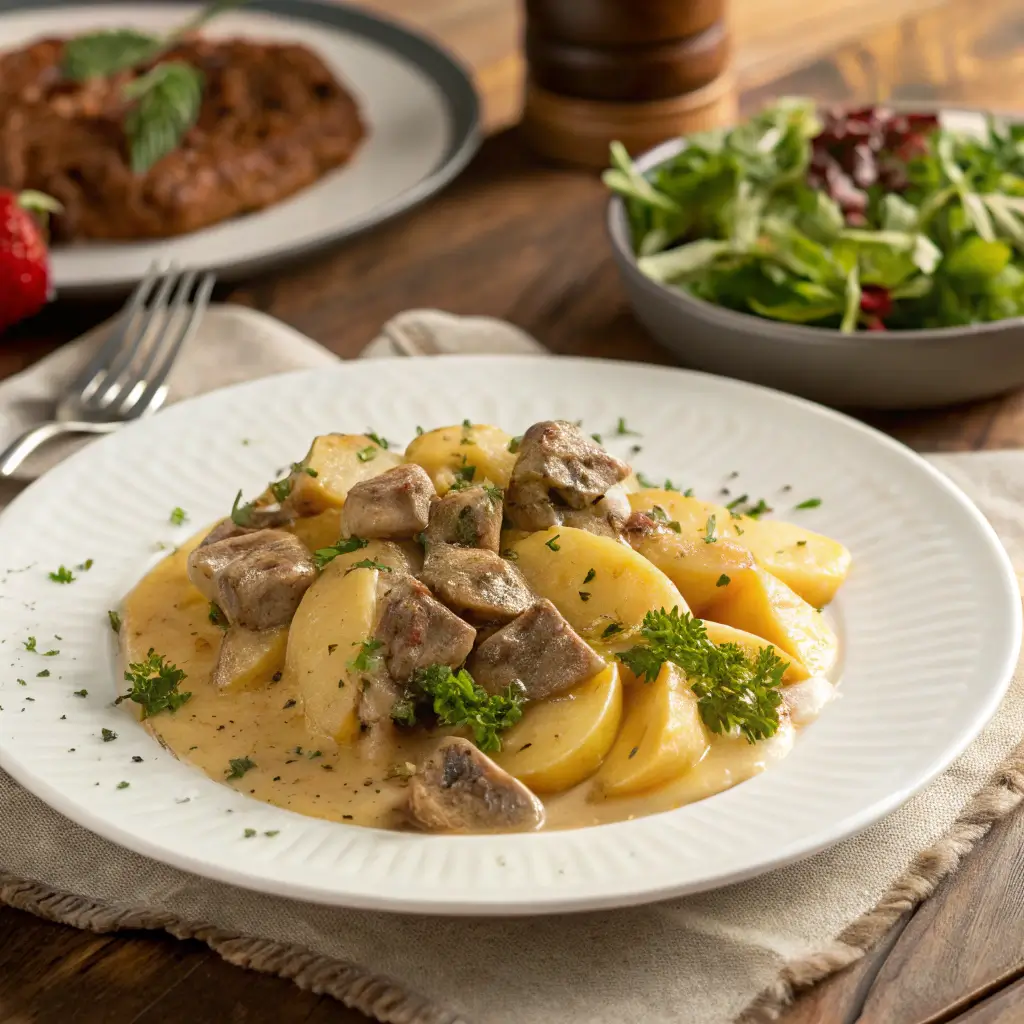
How to Achieve the Perfect Creamy Stroganoff Sauce Without Curdling
The secret to a perfectly smooth and creamy stroganoff sauce lies in how you incorporate the sour cream. Always use room temperature sour cream and take the skillet off the heat before adding it. The process of tempering—adding a bit of the hot liquid to the sour cream before incorporating it back into the dish—is essential for preventing curdling.
Furthermore, once you’ve added the sour cream, avoid boiling the sauce again. The residual heat will be enough to warm everything through without risking separation of the sauce.
Delicious Variations on Classic potatoes Stroganoff
This hearty meal is wonderfully adaptable. Here are some creative variations to try:
Ground Turkey potatoes Stroganoff: A Lighter Alternative
For a lighter version, simply substitute lean ground turkey for the beef. Because ground turkey is typically leaner than beef, you might want to add an extra tablespoon of oil when browning it to ensure it doesn’t dry out. Additionally, you may want to increase the Worcestershire sauce slightly to enhance the umami flavor that beef naturally provides.
Vegetarian potatoes Stroganoff: Plant-Based Comfort Food
To create a vegetarian version, omit the ground beef entirely and double the mushrooms for a meaty texture. Moreover, consider adding 1 cup of cooked lentils for protein and substance. Use vegetable broth instead of beef broth and ensure your Worcestershire sauce is vegetarian (many contain anchovies). For the creamy element, either use your favorite dairy-free sour cream alternative or try plain Greek yogurt for a tangy finish.
Adding Vegetables to Your Potato Stroganoff for a Complete Meal
Transform your potatoes stroganoff into a complete one-pot meal by adding vegetables. Green beans, peas, or diced carrots work wonderfully when added during the last 5-7 minutes of cooking time. Alternatively, baby spinach can be stirred in right before adding the sour cream—it will wilt perfectly from the residual heat.
Make-Ahead, Storage, and Reheating Tips for Leftover potatoes Stroganoff
One of the advantages of this recipe is that it reheats beautifully, making it perfect for meal prep or planned leftovers.
How to Store Leftover potatoes Stroganoff Properly
Store any leftover potatoes stroganoff in an airtight container in the refrigerator for up to 3-4 days. For best results, cool the stroganoff completely before refrigerating to preserve texture and flavor.
Best Practices for Reheating Without Separation
To reheat your leftover stroganoff, warm it gently over low heat in a covered skillet, adding a splash of broth or water to loosen the sauce if needed. Stir occasionally as it warms to ensure even heating. Alternatively, microwave on 70% power in short intervals, stirring between each, to prevent the sauce from separating.
Can You Freeze potatoes Stroganoff?
While it’s possible to freeze potatoes stroganoff, the texture of both the potatoes and the creamy sauce can change upon thawing and reheating. If you do choose to freeze it, do so in an airtight container for up to 2 months. Thaw overnight in the refrigerator before reheating slowly with added liquid to refresh the sauce.
Perfect Pairings: What to Serve with Your Homemade potatoes Stroganoff
Though this dish is hearty and satisfying on its own, pairing it with complementary sides can create a more complete meal experience.
A simple green salad with a light vinaigrette offers a refreshing contrast to the rich, creamy stroganoff. Additionally, steamed green vegetables like broccoli or asparagus provide nutritional balance while adding color to your plate.
For those who enjoy bread with their meals, warm crusty bread or dinner rolls are perfect for sopping up any remaining sauce. Alternatively, if you’re looking for a traditional Eastern European pairing, consider serving with quick-pickled cucumbers or beets for a tangy counterpoint to the creamy dish.
Why This Beef and Potato Stroganoff Recipe is Better Than the Box
When comparing this homemade version to the boxed hamburger helper potatoes stroganoff, the differences become immediately apparent. First, the flavor complexity in the homemade version is significantly more developed, with real mushrooms, fresh onions, and properly browned beef creating a depth that simply can’t be replicated with dehydrated ingredients.
Furthermore, the texture of freshly sliced potatoes is vastly superior to the dehydrated potato slices found in boxed mixes. The potatoes maintain their structure while becoming tender and absorbing the flavors of the sauce.
Most importantly, by making this stroganoff from scratch, you avoid the preservatives, excess sodium, and artificial flavors common in processed foods. The result is not only a more delicious meal but also a more wholesome one that you can feel good about serving to your family.
If you enjoy this homemade potatoes stroganoff recipe, you might also want to try our Easy Potato Stroganoff Recipe Better Than Box for another delicious variation!
Common Mistakes to Avoid When Making Potato Stroganoff
Even experienced cooks can make mistakes when preparing stroganoff. Here are some common pitfalls to avoid:
Overcooking the Potatoes in Your Stroganoff
One of the most common errors is overcooking the potatoes, which can lead to them falling apart and creating a mushy texture. To prevent this, test the potatoes frequently as they near the end of their cooking time. They should be fork-tender but still hold their shape when pierced.
How to Prevent a Gummy or Broken Sauce
A gummy stroganoff can result from improper flour incorporation or starch release from the potatoes. To avoid this, make sure to cook the flour thoroughly with the vegetables before adding liquid, and consider rinsing your sliced potatoes to remove excess starch.
A broken or curdled sauce typically happens when sour cream is added to too hot a mixture or when the stroganoff is boiled after adding the sour cream. Always remove from heat and allow to cool slightly before adding tempered sour cream, and never return to a boil afterward.
Looking for a more traditional approach? Check out our Potato Stroganoff Recipe: How to Make Best for classic techniques and flavors!
Explore More Stroganoff Inspiration
Looking for more delicious stroganoff variations? Check out these related resources:
- The History of Stroganoff: From Russia With Love
- 10 Ways to Use Leftover Stroganoff
- Stroganoff Around the World: International Variations
For a different take on this comfort food classic, don’t miss our Potato Stroganoff Hamburger: Easy Helper Recipe that your family will love!
Frequently Asked Questions About Potato Stroganoff
Can you put potatoes in stroganoff?
Absolutely! While traditional beef stroganoff typically features egg noodles, potatoes make an excellent alternative that creates a heartier, more rustic dish. The starch from the potatoes also helps naturally thicken the sauce as it simmers. Moreover, potatoes absorb the flavors of the stroganoff sauce beautifully, creating a comforting one-pot meal that’s reminiscent of the popular hamburger helper potato stroganoff but with fresher ingredients and better flavor.
What is stroganoff sauce made of?
Traditional stroganoff sauce consists of a base of sautéed onions and mushrooms, beef broth, and sour cream. Additionally, most recipes include flavor enhancers like Worcestershire sauce, dijon mustard, and sometimes a splash of white wine. The sauce is typically thickened with flour or cornstarch and gets its distinctive tanginess from the sour cream added at the end of cooking. In this potato stroganoff recipe, these elements combine to create a rich, creamy sauce that perfectly complements both the ground beef and tender potato slices.
What’s the difference between Hamburger Helper and stroganoff?
Hamburger Helper is a boxed meal kit that contains pasta or dehydrated potato slices and seasoning packets, requiring only the addition of ground beef and sometimes milk. Stroganoff, on the other hand, is a traditional dish that originated in Russia, typically made with beef strips, mushrooms, and sour cream. The hamburger helper potato stroganoff variety attempts to recreate the flavors of traditional stroganoff in a convenient format but uses ground beef instead of beef strips and often contains artificial ingredients and preservatives. Homemade versions, like this copycat recipe, capture the authentic flavors of stroganoff while using ground beef for accessibility and affordability.
What’s the difference between stroganoff and goulash?
Though both are comforting beef dishes, stroganoff and goulash have distinct differences in origin, ingredients, and flavor profiles. Stroganoff originated in Russia and features a creamy sauce made with sour cream, mushrooms, and sometimes wine. Goulash, meanwhile, is a Hungarian dish characterized by a paprika-seasoned tomato-based sauce, often containing bell peppers and sometimes potatoes. Stroganoff typically has a milder, creamier taste while goulash offers a more robust, slightly spicy flavor profile. Furthermore, goulash is usually served with dumplings or bread, whereas stroganoff is traditionally served with noodles or, in this case, cooked with potatoes.
What does sour cream do to mashed potatoes?
Sour cream adds both creaminess and tanginess to mashed potatoes, creating a richer texture and more complex flavor profile. The fat content in sour cream contributes to the silky texture, while its acidity cuts through the starchiness of the potatoes. Additionally, sour cream helps mashed potatoes retain moisture, preventing them from becoming gluey or dry. In this potato stroganoff recipe, though we’re not making mashed potatoes, the sour cream serves a similar purpose by adding richness and tang to the sauce that coats the sliced potatoes, enhancing the overall dish.
Should you soak potatoes before sauteing?
Soaking sliced potatoes before cooking them can be beneficial, particularly when making potato stroganoff. Soaking in cold water for 15-30 minutes helps remove excess starch, which prevents the potatoes from sticking together and reduces the risk of a gummy sauce. Furthermore, it helps the potatoes maintain their shape during cooking rather than falling apart. When making this stroganoff recipe, soaking the sliced potatoes while preparing the other ingredients is an easy extra step that noticeably improves the final texture of the dish.
What is the difference between deluxe stroganoff and regular stroganoff?
Deluxe stroganoff typically includes additional premium ingredients not found in regular versions. These might include higher quality cuts of beef, a greater variety of mushrooms (perhaps including wild mushrooms), the addition of white wine, and sometimes cream in addition to sour cream for an even richer sauce. In the context of hamburger helper varieties, their “deluxe” stroganoff often contains more dried vegetables and a creamier sauce mix. This homemade potato stroganoff recipe can easily be elevated to “deluxe” status by using a combination of mushroom varieties and adding a splash of white wine during the deglazing step.
What is the best substitute for sour cream in stroganoff?
If you need to substitute sour cream in your potato stroganoff, several options work well. Plain Greek yogurt is the closest match in terms of texture and tanginess, though it’s slightly less rich. Crème fraîche offers a luxurious alternative with less risk of curdling when heated. Dairy-free options include cashew cream with a splash of lemon juice or coconut cream (though this will add a slight coconut flavor). For any substitute, remember to temper it before adding to the hot mixture and avoid boiling after it’s incorporated to prevent separation.
What is the best cut of meat for stroganoff?
Traditional stroganoff uses tender cuts of beef like tenderloin or ribeye, thinly sliced against the grain. However, this potato stroganoff recipe calls for ground beef for simplicity and affordability, making it more accessible for everyday cooking. If you prefer to use whole cuts in this recipe, sirloin works well as a middle-ground option offering good flavor without breaking the budget. The key to any stroganoff, regardless of the cut, is proper browning to develop flavor before creating the sauce.
What can I add to stroganoff for more flavor?
To enhance the flavor profile of your potato stroganoff, consider these additions: a tablespoon of tomato paste browned with the onions adds umami depth; a teaspoon of smoked paprika brings subtle smokiness; a splash of brandy or white wine deglazes the pan and adds complexity; fresh herbs like thyme or dill brighten the dish; and sautéed garlic adds aromatic richness. Additionally, using a mix of mushroom varieties like cremini, shiitake, and oyster mushrooms creates more interesting texture and flavor than using just one type.
What ethnicity is stroganoff?
Stroganoff originated in Russia in the 19th century and is named after Count Pavel Alexandrovich Stroganov, a member of a wealthy Russian family. The dish became popular in Russian cuisine before spreading throughout Eastern Europe and eventually worldwide. The original Russian version featured thin strips of beef in a sour-cream based sauce. As stroganoff traveled around the world, it was adapted to local tastes and ingredients, leading to variations like the American hamburger helper potato stroganoff that uses ground beef and, in this case, potatoes instead of the traditional egg noodles.
Why is my stroganoff gummy?
Gummy stroganoff can result from several factors. First, potatoes release starch when cooked, which can thicken the sauce too much – soaking sliced potatoes in water before cooking helps prevent this. Second, improper flour incorporation can create lumps; always cook flour with fat before adding liquid and whisk well when adding broth. Third, overcooking the potatoes causes them to break down and release more starch. Finally, boiling the stroganoff after adding sour cream can cause separation and an unpleasant texture. To fix slightly gummy stroganoff, try thinning with warm broth while gently stirring until the desired consistency is reached.
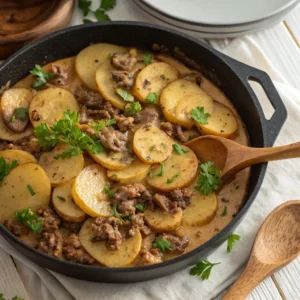
Copycat Hamburger Helper potatoes stroganoff
Equipment
- 1 Large skillet with lid
- 1 Mandolin or sharp knife For uniform potato slices
- 1 Mixing Bowl
- 1 Whisk
- 1 wooden spoon or spatula
Ingredients
For the Stroganoff Base
- 2 tablespoons vegetable oil Divided
- 1 pound lean ground beef 85-90% lean recommended
- 1 large onion Finely chopped
- 3 cloves garlic Minced
- 8 ounces mushrooms Cremini or white button cleaned and sliced
- 2 tablespoons all-purpose flour
- 1 teaspoon paprika
- ½ teaspoon dried thyme
- 1 teaspoon salt Adjust to taste
- ½ teaspoon black pepper
- 2 cups beef broth Low sodium recommended
- 1 tablespoon Worcestershire sauce
- 1 teaspoon dijon mustard
- 1½ pounds russet potatoes About 3 medium sliced ¼-inch thick
For the Creamy Finish
- ¾ cup sour cream At room temperature
- 2 tablespoons fresh parsley Chopped for garnish
Instructions
- Slice potatoes into uniform ¼-inch thick pieces using a mandolin or sharp knife. Place them in cold water to prevent browning while preparing other ingredients.1½ pounds russet potatoes About 3 medium
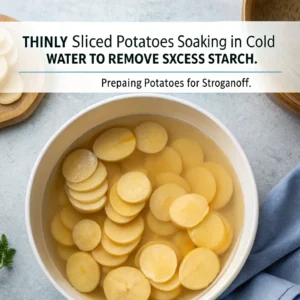
- Heat 1 tablespoon oil in a large skillet over medium-high heat. Add ground beef and cook, breaking apart with a spoon, until deeply browned (5-7 minutes). Drain excess fat and set beef aside.2 tablespoons vegetable oil Divided, 1 pound lean ground beef 85-90% lean recommended
- In the same skillet, add remaining tablespoon of oil. Sauté onions until translucent (4-5 minutes), then add garlic and mushrooms. Cook until mushrooms release liquid and begin to brown (5-7 minutes).1 large onion Finely chopped, 3 cloves garlic Minced, 8 ounces mushrooms Cremini or white button, 2 tablespoons vegetable oil Divided

- Sprinkle flour, paprika, thyme, salt, and pepper over the vegetable mixture. Stir constantly for 1-2 minutes to cook out the raw flour taste.2 tablespoons all-purpose flour, 1 teaspoon paprika, ½ teaspoon dried thyme, 1 teaspoon salt Adjust to taste, ½ teaspoon black pepper
- Gradually pour in beef broth while whisking to prevent lumps. Stir in Worcestershire sauce and dijon mustard, then bring mixture to a simmer.2 cups beef broth Low sodium recommended, 1 tablespoon Worcestershire sauce, 1 teaspoon dijon mustard
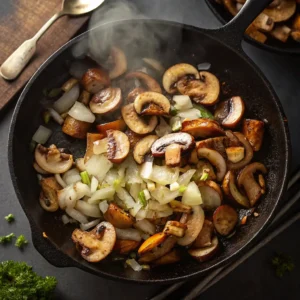
- Drain and pat dry the potato slices. Return beef to skillet, then gently fold in potato slices, ensuring they’re mostly submerged in liquid.1½ pounds russet potatoes About 3 medium, 1 pound lean ground beef 85-90% lean recommended
- Bring to a gentle simmer, reduce heat to low, cover, and cook for 18-20 minutes, or until potatoes are fork-tender but not falling apart. Stir occasionally to prevent sticking.
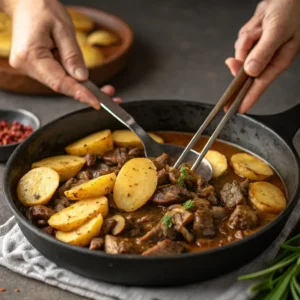
- Remove skillet from heat and allow to cool slightly. In a small bowl, whisk a few spoonfuls of hot liquid from the skillet into the room-temperature sour cream to temper it.¾ cup sour cream At room temperature
- Gently stir the tempered sour cream into the skillet until fully incorporated and sauce becomes creamy. Do not return to boil after adding sour cream.¾ cup sour cream At room temperature
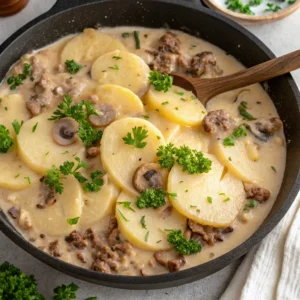
- Taste and adjust seasoning as needed. Serve hot, garnished with fresh chopped parsley.1 teaspoon salt Adjust to taste, 2 tablespoons fresh parsley Chopped, ½ teaspoon black pepper

Notes
- For best results, ensure sour cream is at room temperature before adding to prevent curdling.
- Yukon Gold potatoes can be substituted for russets for a more buttery flavor.
- To make ahead, store in an airtight container in the refrigerator for up to 3-4 days. Reheat gently with a splash of broth.
- For a lighter version, substitute ground turkey for beef.
- Make it vegetarian by doubling the mushrooms and using vegetable broth instead of beef broth.
- Add green beans, peas, or spinach in the last few minutes of cooking for added vegetables.

